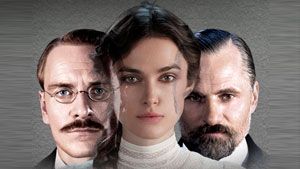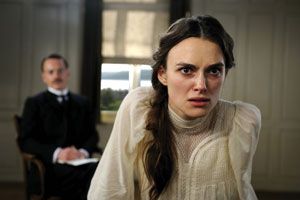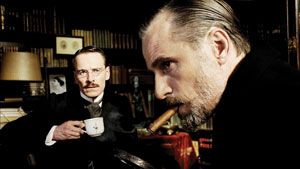Publication
Article
Psychiatric Times
A Dangerous Method
Author(s):
David Cronenberg’s film "A Dangerous Method" tells the story of the relationship between Freud and Jung and a woman named Sabina who had a considerable influence on both of them.

- David Cronenberg’s film A Dangerous Method tells the story of the relationship between Freud (Viggo Mortensen) and Jung (Michael Fassbender) and a woman named Sabina (Keira Knightley) who had a considerable influence on both of them. © Sony Pictures Classics
A century after it happened, the clash of the Titans of psychoanalysis, Freud and Jung, has made its way into the cineplex in David Cronenberg’s new film, A Dangerous Method. The critics are giving it thumbs up for its achievement in bringing a moment in intellectual history to life for general audiences. And disciples of both men will have to admit that it’s not the muck-raking expos it could have been. There is, for example, no mention of Freud’s adventure with cocaine, nor Jung’s early ideas about a racial unconscious.
What supplies the melodrama required for film is Sabina Spielrein (Keira Knightley) who, as it turns out, was an important player in the clash between the great men. Spielrein was virtually unknown until the 1970s, when her papers were discovered in an archive in Geneva. She was psychoanalyzed by Jung (Michael Fassbender), consulted with Freud (Viggo Mortensen), and became a leading psychoanalyst in the Soviet Union, where she and her daughters were murdered by the Nazis. Her papers suggested that she made unacknowledged contributions to both of the great men’s theories. But what sent shock waves through the psychoanalytic community, reeling in the 1970s from accusations of patient sexual abuse, was the revelation that Jung had a prolonged affair with her.
Spielrein, the daughter of a wealthy Russian Jewish family, had been admitted to Bleuler’s famous Burghlzli psychiatric clinic in Zurich at age 18 with the diagnosis of hysterical psychosis. There she came under the care of Jung, who decided to employ for the first time Freud’s dangerous method-The Talking Cure. Dangerous because the intimate fantasies and feelings explored in the treatment can stir up sexual longings in the unwary therapist as well as the patient. That is apparently what occurred in Jung’s first analysis, and he succumbed to the temptation. Freud had anointed Jung as his apostle, “his son and heir,” hoping that the Swiss Protestant psychiatrist, the son of a pastor, would add respectability to what his detractors called the “Jewish Science.” One can only wonder how Freud must have felt when he learned that his prized Christian disciple was having sex with his young Jewish patient. Cronenberg’s film tells the story of Sabina Spielrein’s crucial role in making and breaking the Freud/Jung relationship.
The Spielrein revelations produced a cottage industry of professional articles, plays, and films, and a book by psychologist John Kerr, A Most Dangerous Method. Christopher Hampton-who had with stunning success adapted the classic French novel Liaisons Dangereuses for the stage and then for the screen-used Kerr’s book and the Freud/Jung correspondence to construct The Talking Cure, a play that opened in 2002 in London’s National Theatre. He would then create the screenplay filmed by Cronenberg in 2011.
Hampton is a gifted dramatist, and something should be said about the theatrical version. Disaster struck during rehearsal when the actor who was to play the part of Freud died and a young understudy who lacked gravitas was pressed into service. Ralph Fiennes as Jung towered over the Freud character. Fiennes’ Jung owed much to his Count Laszlo de Almsy, the passionate doomed lover in The English Patient-the role that made him an international star. His Jung was also the Nietzschean Ubermensch to whom middle-class morality does not apply, a man destined for greatness and the bout of madness he chronicled in his Red Book. The seduction of his patient seemed a Dionysian happening rather than a boundary violation. Fiennes made it an unforgettable night at the theater, but the cogency and cunning of Hampton’s dramatic adaptation was lost in the bravura. Critics who stopped to think about the play were not impressed by the dramatic urgency of the lines, some of them taken directly from the Freud/Jung correspondence, and wondered what to make of the argument between the two men today when the theories of both have long since been discredited by serious psychologists. Obviously, the play as performed conveyed no sense of the cultural sig-nificance of Freud and Jung, who may not have been scientists but who did transform the 20th century’s understanding of the human condition.

Almost a decade later, Hampton gets a second chance. The film re-titled A Dangerous Method is brought to us in a beautifully crafted costume dra-ma that features wide-angle close-ups in which every shot is a work of art, Jung and Freud are iconic, and Hampton’s screenplay is fully realized. David Cronenberg was an unexpected choice to direct the film. Cronenberg, a Canadian, cut his teeth as an auteur making low-budget horror films. He is known for a mix of sci-fi and grotesque violence, exploding heads being only one extreme example. He also seems to be drawn to the sexually perverse, as in Crash. Not the bland Oscar-winning film with the same title, but a nightmarish portrayal of people who can only get sexually aroused by violent automobile collisions. It is a cult classic of sadomasochism that gives new meaning to the term “autoeroticism.” His recent films, The History of Violence and Eastern Promises featuring Viggo Mortensen, are more mainstream, but there is still something perversely erotic-even orgiastic-in the violent encounters. Sadomasochism is Sabina Spielrein’s sexual fixation, and so Cronenberg is on familiar ground.
Christopher Hampton’s screenplay places Sabina Spielrein at the apex of the triangle with Jung and Freud. She is the demonic force. The opening scene has her being dragged from a horse and carriage kicking, screaming, and laughing hysterically. Keira Knightley was chosen to play the role and her performance has been a lightning rod for critical reaction. Many are put off by the opening scenes, the grimacing, the writhing of the limbs, the spasmodic speech, and the desperate protrusion of her naturally long jaw. The most mistaken response is that “the woman” cannot act. In fact, this may be the remarkable actress’s bravest performance. She studied the Burghlzli’s medical records of Spielrein’s symptoms and attempted to simulate them. She willingly made herself look repulsive in order to inhabit Sabina Spielrein-a “hysterical psychotic” in 1904. Psychiatrists know that the way mental illness expresses itself changes with time and place. Knightley is true to the clinical description of that earlier time, although grotesque and alien when seen through the lens of contemporary sensibility. Her sexual thoughts and feelings disgust her-they make her nauseous-and those inner feelings are “converted” into facial contortions (the protruding jaw) as though she were retching. And Cronenberg, as he told an interviewer, encouraged Knightley in this “conversion,” “the words are trying to come up . . . you can’t allow them to come out.”
The real Spielrein had overactive emotional reactions, but she was also a well-educated and brilliant woman. In Hampton’s screenplay, she is more psychologically minded than Jung and understands him better than he does himself. Hampton adroitly puts one of Jung’s famous ideas into one of Spielrein’s spontaneous lines. When Jung succumbs to temptation and accepts her invitation to a tryst, she welcomes him into the room and kisses him on the lips. He backs away and with a conventional reaction asks her, “Don’t you think the man should take the initiative?” With a knowing smile she responds, “Don’t you think there is something of the man in every woman and something of the woman in every man?” Jung looks quizzical as if he never thought of that idea. It would become one his most basic archetypal theories, Latinized by him as the Anima and the Animus.
I credit Hampton for knowing that most of his audience would miss the deeper significance of this exchange, but those steeped in psychoanalytic theory would not. I also assume that in his depiction of Jung and Freud, he was speaking both to his general audience and to those still invested in their disputes. For the general audiences, Jung is the cowboy in the white hat and Freud is wearing the black hat. If Ralph Fiennes’ Jung was Nietzschean man, a genius in statu nascendi, Michael Fassbender’s Jung is Candide: too innocent to seduce anyone . . . indeed too innocent to blame for his violation of his Hippocratic Oath.

As Hampton has crafted Jung and as Fassbender plays him, his main quality is his innate decency. There is no trace of the mystical leaning that already preoccupied Jung; if anything, he is the archetype of the good doctor and budding scientist. From his first friendly encounter with Spielrein, he treats her as an equal, with consideration and respect. She responds to that decency at least as much as to the erotic longings released by the abreaction of her masochistic fixation. Those in the profession will recognize that Hampton’s Jung is trying to create what is called today a therapeutic alliance. The movie foregrounds the perverse contents of the therapy; when as a child her father spanked her naked bottom, she became sexually excited. That is the perverse core of her neurotic conflict, revulsion and excitement are almost inextricably linked in her psyche. Painful humiliation is her aphrodisiac, and she despises herself for this. As often happens in actual therapy, as she abreacts all this to the supportive and friendly Jung, she falls madly in love with him.
It was during this honeymoon stage of the therapy that Jung began his friendly-indeed adulatory-correspondence with Freud. Meanwhile, Speilrein was doing everything in her power to seduce Jung, and the thoroughly decent Swiss Protestant resisted. He was married and believed in monogamy. He had a very wealthy and very doting wife who seemed to understand better than he what was happening to him in his treatment of Spielrein.
In Christopher Hampton’s telling, what sends Jung over the edge is the arrival of a new patient, Otto Gross (Vincent Cassel), sent to him by Freud. Gross has a place in the official history of psychoanalysis. The son of Austria’s most famous criminologist, he was a brilliant physician and one of the first psychoanalysts. Yet he was hopelessly addicted to narcotics. Freud sent him to the Burghlzli in the hope that he could break his addiction and come back to Vienna for analysis with him. Gross had already been practicing analysis and, as he tells Jung, has been sleeping with all his women patients. His basic premise is that all repression is bad and that Freud is obsessed with sex because he is not getting any.
Hampton, preserving Jung’s good guy Adam before the fall persona, introduces Gross as the serpent in the garden. Gross was radical in his views about sexual repression, but he was also a political radical-an anarchist. Hampton gives us Gross with the politics left out; but in their therapeutic sessions, he is more Jung’s doctor than his patient, and when he elopes from the hospital he leaves a written prescription: sex with Spielrein. And Jung takes the medicine.
There is something childlike about Fassbender’s Jung that keeps his white hat in place even as he is enacting Spielrein’s masturbation fantasy and spanking her buttocks. Having sex with a patient is a serious ethical violation, destructive if not ruinous to the patient akin to the damage caused by incest. That is the prevailing view of contemporary experts. But Spielrein prospers, decides to go to medical school, and becomes a psychiatrist and a psychoanalyst. She is unhappy only when Jung breaks off the affair. For the general audience, Jung’s innocent childlike persona and her aggressive sexual overtures take most of the sting out of the offense. There is, I believe, a deeper argument also being made by Hampton against the certitude of contemporary experts.
When the Titans went their separate ways, Jung developed his own theory of how analysis cured. The person had to do more than come to understand himself: he had to discover what he could be . . . he had to create a sense of what he might become. This is what Spielrein explains to Freud in the film when they meet and he rejects it out of hand. But for Hampton, the transformative Jungian cure is the basis of his deeper argument and central to the underlying, more sophisticated narrative. Jung gives Spielrein the sense that she, “an insane patient,” can become a psychoanalyst in her own right. That sense of what she can become is her cure! Jung is very much her patient as well as her doctor, and she shows him what he can become. Their adulterous affair not only was good for her, but also it empowers him, unlocks his genius, and helps him break out of the straightjacket of conventional wisdom. Hampton’s Jung underlines this, telling Spielrein she was the most important love of his life. She gave him a sense of what he could become. They have cured each other and the illicit affair was part of that cure. With Wagner’s Siegfried’s Idyll playing in the background (Siegfried is the heroic offspring of the incestuous affair between Sigmund and Sieglinde in the Ring Cycle), Spielrein assures Jung that good things can come out of bad, that perhaps true creativity requires such boundary violations.
Jung’s therapy of “salvation,” as it is called by Philip Rieff, has captured the imagination of contemporary new wave psychology that embraces Jung’s mysticism. Jungians also claim credit for the spiritual element in all of the 12-step programs that play such an important role in contemporary therapeutic endeavors. But most American psychiatrists know almost nothing about Carl Jung. A Dangerous Method should spark their interest.
There is another mystical Jungian element that general audiences might not fully register. Jung believed that dreams (and particularly his own dreams) could be prophetic. In the last scene of the film, a pregnant Spielrein, now married to a “kind” Jewish doctor, visits Jung. He is troubled, not sleeping at night, and on the verge of his “nervous breakdown.” Spielrein was his guide and mistress on his first empowering journey, and Toni Wolff, another analysand and mistress, would steer him through his impending psychosis and help him record it in The Red Book. Spielrein extracts Jung’s confession about his new mistress whom she emphasizes is like her, an analysand and half Jewish. Neither agreeing nor disagreeing with Spielrein’s observation, he responds, “My wife is the foundation of my house, Toni perfumes the air.” He is no longer a monogamist; in fact, both women, like Spielrein, went on to be Jungian analysts and found a new identity sharing the great man’s life.
Jung tells Spielrein the dream that is waking him at night. A flood is sweeping over Europe and it reaches Switzerland as an avalanche of blood. Spielrein asks him what the dream means; he answers that he doesn’t know unless “It’s about to happen.” It is 1913 and his dream on the eve of the First World War is prophecy. Hampton’s Jung is not just a genius: he is a divine.
I have said nothing about Viggo Mortensen’s Freud. Mortensen is an actor of great talent and charisma, and certainly on screen he is a match for Fassbender and his resemblance to Freud is uncanny. But speaking Hampton’s lines, his Freud is small-minded, reductive, doctrinaire, and manipulative. There is no sign of the mind that gave birth to the Interpretation of Dreams,the book that earned the real Jung’s unqualified admiration. Freud opened a road into the world of the unconscious that Jung traveled for the rest of his life, and where he found his archetypes.
The film does not have a happy ending, but for Sabina Spielrein and the “spirit” of Carl Jung it is a vindication. Other mental health professionals may well interpret this film quite differently, but anyone interested in psychoanalysis or analytical therapy owes it to himself or herself to see and discuss A Dangerous Method with colleagues.






